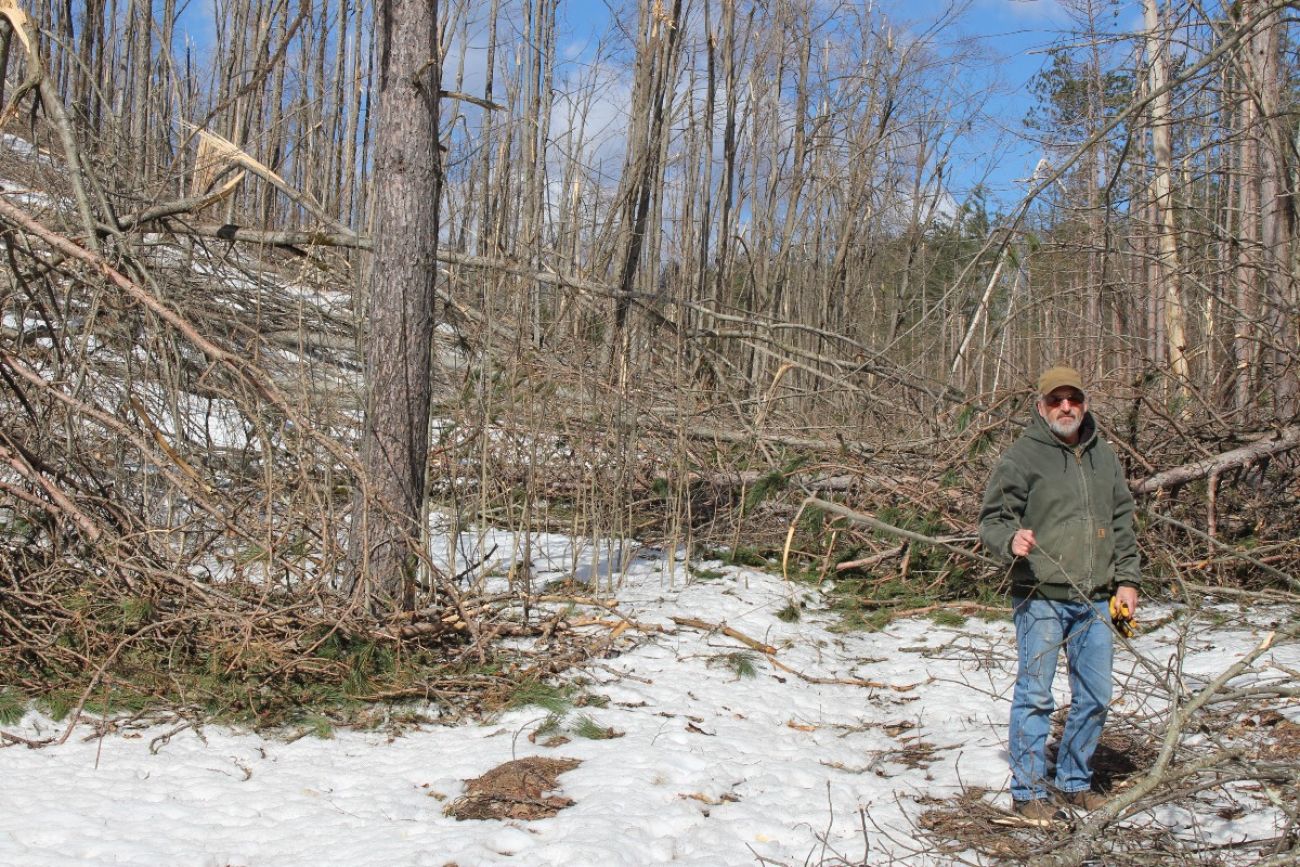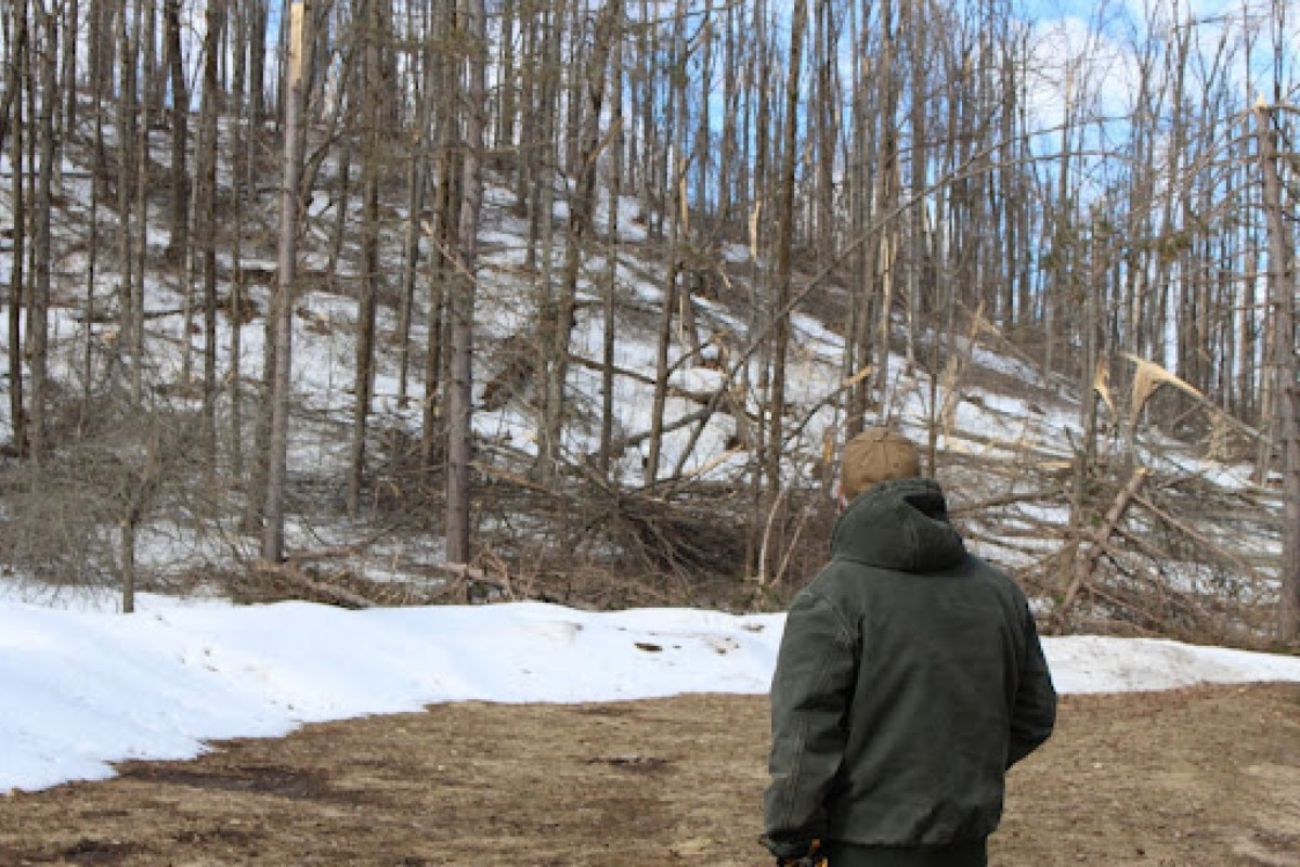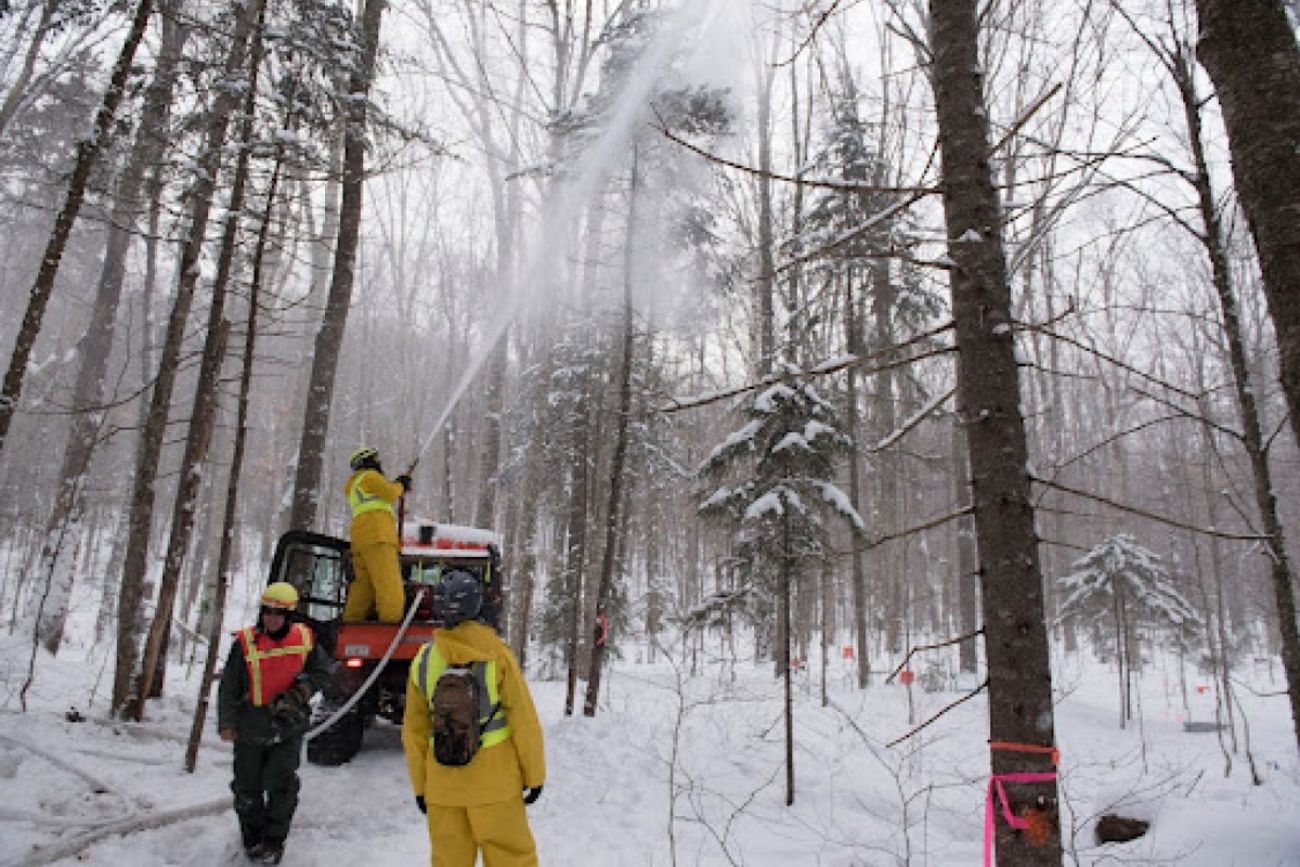Slammed by northern Michigan ice storm, foresters wonder what’s next

- A historic ice storm in late March destroyed millions of trees across a dozen counties in northern Michigan
- Forest owners can apply for federal assistance with restoration
- Foresters think it’ll take years to get back to normal — if they ever do
When a once-in-a-generation ice storm slammed northern Michigan in late March, damaging hundreds of miles of forest, Bill Sterrett hoped his decades of careful management might help his woodlot north of Gaylord fare a little better.
It didn’t.
“The first thing I saw was these pine right here, and I was looking for green,” he said. “There's green up there, but it's not green like it was. If I had to count, 80% of them are sheared off right at the top, and they're just standing there.”
Northern Michigan’s ice storm that lasted from March 28 through March 30 devastated power lines and roads, but it also plowed through a huge swath of woods stretching from Lake Michigan to Lake Huron, toppling millions of trees. In the aftermath, people across the region are still figuring out what the wreckage means for the forest itself and for those who rely on it.
Michigan’s forest industry contributed $26.5 billion to Michigan’s economy in 2022, the most recent year for which data’s available, according to the Michigan Department of Natural Resources. The US Forest Service says Michigan ranks 10th in the nation for forest land area, with 20.2 million acres of forestland, most of it in the northern part of the Lower Peninsula and the Upper Peninsula.
Unlike a tornado, which touches down and causes damage for a few miles, the ice storm swept across 12 counties.
Salvage wood — of which there’s an abundance after the storm — fetches roughly half the value of regular trees. And there’s no insurance available for timber grown by private landowners like Sterrett.
A little farther into Sterrett’s property, a hillside full of hardwoods — old sugar maples, oaks and basswood — looks the same as the damaged pine. Some tops were sheared off like the pine. Others look like they’ve been split by a giant, imprecise ax. Almost all of them show the white, inner sapwood that’s usually covered by bark.
Sterrett had been managing much of his woods for high quality veneer that’s used for things like doors, furniture and cabinets.
He estimates he’s lost 90% of the value of his timber, taking about a $40,000 loss on the veneer-quality wood alone.
“Normally, if we were standing here, we wouldn't feel the wind,” Sterrett said. “We might hear it at the tops. But we feel the wind down here at ground level now. I'm not used to that. Because the forest is so open now, the wind is just coming through. There's nothing to block it, anymore, because the crowns of the trees, the tops of the trees, are gone.”

Some help on the way
Sterrett is one of many landowners across the region who’s hoping to squeeze what little remaining value his damaged trees can offer.
Foresters can ask the federal government for up to $500,000 to cover up to 75% of the cost of forest restoration through the U.S. Forest Service Agency’s Emergency Forest Restoration Program. Foresters apply through local Forest Service Agency branches.
The Michigan Forest Service Agency is still assessing the damage and hasn’t yet opened up the application process for those affected by the ice storm, Kelly Losey, the agency’s agricultural program specialist, said in an email to Bridge Michigan. The agency hopes to open applications within three weeks, she said.
Gov. Gretchen Whitmer has called on President Donald Trump to declare a federal disaster for northern Michigan, which would open up more resources for property owners and businesses affected by the storm — including foresters.
Trump has yet to make that declaration.
RELATED:
- Days after storms, thousands still without power. That’s the norm in Michigan
- After ice storm, more than a dozen Michigan state parks remain closed indefinitely
- 30,000 gallons of maple syrup likely lost in historic Michigan ice storm
A presidential disaster declaration isn’t necessary for Emergency Forest Restoration Program funds to become available.
Meanwhile, U.S. Rep. Haley Stevens, a Democrat from Rochester Hills, last week introduced a bill that would allow the president to use prolonged power outages as the basis for declaring a federal disaster. Nearly 7,000 utility customers in northern Michigan remained without power Tuesday afternoon, more than two weeks after the storm.
‘The markets are suddenly flooded’
Justin Knepper, executive director of the Michigan Association of Timbermen, said Michigan’s forest products industry was already experiencing a downturn before the storm, with fewer loggers to cut trees and fewer sawmills to process them.
Now, there’s a glut of wood from the storm.
“The markets are suddenly flooded with way more than they need,” Knepper said. “The saddest part is, a substantial amount of it is just not going to be able to be utilized, because there's so much all at once. There's not enough loggers out there to clean it all up quick enough, from what we know.”
Time is working against loggers and landowners as downed trees begin to rot, ruining salvage value and attracting pests that could spread to surviving trees.
Beyond that, Knepper said northern Michigan’s sawmills likely won’t have enough processing or storage capacity for all the wood, even if loggers could bring it in.
“It’s like if you had the biggest garden in the world, and you're like, ‘Hey, I only need 10 beets.’ And I'm like, ‘Well, go pick 10,000 beets and then figure out how to eat them all,’” Knepper said.
‘It’s a lot’
The DNR is still assessing the exact number of trees damaged across nearly a million acres of impacted state forest.
“This is really ballpark, napkin-type math — 100 trees to the acre wouldn't be unreal,” said Jeff Stampfly, chief of the DNR’s forest resources division and Michigan’s state forester. “It's a lot. It's a lot.”
It’s potentially tens of millions of trees, by that math. The financial losses aren’t yet clear.
For vacationers and passersby, the hardest-hit woods will look and feel different for an entire generation. Tree crowns are completely or partially gone. Where before you might’ve been able to walk through the woods, you can’t now.
All that woody debris on the ground can create more diverse wildlife habitat, but it also provides lots of fuel for forest fires.
“There'll be an increased amount of down and dead timber in there for several years that, in a drought-type summer, would be available to burn that otherwise wouldn't,” Stampfly said.
He said the debris is creating a situation similar to that of North Carolina, where tree damage from Hurricane Helene helped lay the foundation for wildfires this spring.
Some parts of northern Michigan will likely be clear cut “in order to make sure that the next forest that we're going to have to grow back is as disease-free and as healthy as we can get it,” Stampfly said. “By leaving partial stands that are busted up pretty bad, it's a real good vector for disease to come into the stand and impact the subsequent stands.”
‘Incredibly resilient’
The National Weather Service in Gaylord estimates the last time Michigan experienced an ice storm this severe was in 1922.
But New England had one in 1998, and it prompted scientists there to recreate ice storms in a controlled setting beginning in 2015. A group of researchers sprayed freezing water into an experimental forest, then watched what happened.
Lindsey Rustad, a retired forest ecologist with the U.S. Forest Service, said the forest canopy changed dramatically in the immediate aftermath.
“It opened up, and it was more ragged. It's probably what your forests look like right now,” Rustad said.

Several years after the storm, the canopy started changing again.
“Our trees come back. They're incredibly resilient,” she said. “They put out more leaves. They filled in some of the holes in the canopy.”
But despite the regrowth, the health of those trees is a different story.
“Those trees that were damaged during the ice storm, they continue to get sicker over time,” Rustad said. “They had to put so much of their energy into repairing the damage and the ripping and the shredding that they were just in decline.”
In the future, researchers want to see whether the experimental forest in New England is more susceptible to stressors like droughts, heat waves, insects — and maybe more ice storms.
“If you talk to climate scientists and peer into the crystal ball of the future, the expectation is that we're going to see more frequent and more intense ice storms under a warming climate,” Rustad said. “And it's because of that that we feel it's somewhat urgent to understand the impact of ice storms now.”
‘Something you don’t forget’
Only two weeks after Michigan’s storm, though, people are still figuring out how to move forward.
Jennifer and Troy RiChard produce maple syrup and other maple products in Gaylord. The couple took out nearly half a million dollars in loans to start their business, Hidden Acres Sugar Bush, five years ago.
They couldn’t check on their 17,000 tapped maple trees until after the storm ended.
“For the short amount of time that we were at the property, it was something you don't forget,” Jennifer RiChard said. “You're watching everything you built just crumble.”
She estimates they’ve lost about $400,000 dollars in damaged trees and maple lines, plus revenue lost from future tapping.
“You couldn't see the maple lines. (They’re) bright blue lines. You couldn't see them. They were under thousands of tree tops, and it was devastating,” she said.
RiChard estimated it would take about five years to clear all the debris and get the maple lines back up, running sap from their trees to their pumphouse. But volunteers from the Mennonite community and from other maple-producing areas of the Midwest helped clear trees and get some lines back up in a week.

Still, Jennifer RiChard said they’re bringing in less than a quarter of the sap they usually would this time of year.
They’re not alone. The Michigan Maple Syrup Association said around a third of the state’s annual maple syrup output was lost to storm damage.
“But it's something,” Jennifer RiChard said. “And if we can get to our bare minimums and pay our loans, we're going to keep going.”
She estimates they’ve lost roughly half of their sugar maples, which have to be around 40 years old to tap. They won’t know exact numbers until they see what does — or doesn’t — regrow as the weather warms.
Apart from coverage on equipment and final maple products, insurance isn’t available for the maple trees themselves. Jennifer RiChard said she and her husband hope to get disaster assistance from programs through the U.S. Department of Agriculture.
But no amount of money will bring back the decades-old trees they lost, said Troy RiChard.
“Our trees aren’t gonna recover for 30, 40 years,” he said. “We're gonna pass this business on to our kids.”
“Will it be there?” Jennifer responded.
Bridge Michigan Regional Editor Justin A. Hinkley contributed to this report.
See what new members are saying about why they donated to Bridge Michigan:
- “In order for this information to be accurate and unbiased it must be underwritten by its readers, not by special interests.” - Larry S.
- “Not many other media sources report on the topics Bridge does.” - Susan B.
- “Your journalism is outstanding and rare these days.” - Mark S.
If you want to ensure the future of nonpartisan, nonprofit Michigan journalism, please become a member today. You, too, will be asked why you donated and maybe we'll feature your quote next time!




